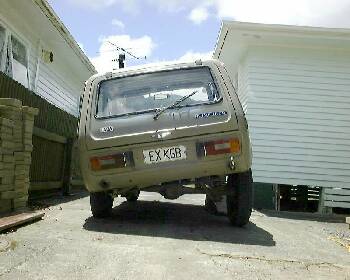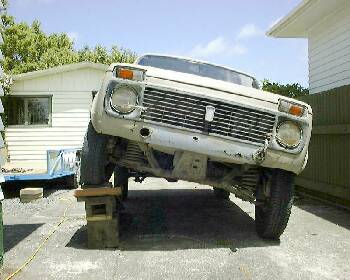The plank I have placed across the blocks is 1450mm long and at its highest point measures 495mm off the ground. To my suprise the Niva easily drove to the top of this ramp and still had all four wheels on the ground. This gives an RTI index of 659. (1450/2200=0.659, 0.659x1000=659)
I will have to build a longer ramp to see what it is really capable of, but building a ramp out of blocks like this one is not such a good idea. With at least half the vehicle weight on the one front wheel up the ramp it was pretty wobbly and not safe.
Below is table downloaded of the internet of some RTI indexes of a variety of vehicles as tested by the american Four Wheeler magazine.
| Vehicle RTI |
Vehicle RTI |
| '96 Jeep Wrangler: 357 |
'93 Isuzu Trooper RS 2-dr.: 529 |
| 95 GMC Jimmy 4-dr. 371 |
'97 Jeep Wrangler: 532 |
| '92 Suzuki Vitara 4-dr. 379 |
'94 Dodge Ram 1500: 556 |
| '93 AM General Hummer: 385 |
'94 Land Rover Defender 90: 580 |
| '93 Isuzu Rodeo LS: 435 |
'95 Land Rover Discovery 588 |
| '93 Jeep Grand Cherokee: 439 |
'93 Range Rover County LWB 588 |
| '93 Toyota 4Runner: 441 |
'93 Toyota Land Cruiser: 593 |
| '94 Ford Explorer Limited 443 |
'96 Range Rover 4.0SE: 600 |
| 96 Nissan Pathfinder: 466 |
'92 Range Rover Classic: 670 |
| '96 Kia Sportage: 471 |
'80 Range Rover 2dr Classic 730 |
As you can see my figure of 659 compares very favourably with the results in the table above with only the older model Range Rovers surpassing this mark. I would be interested in finding out what the RTI index is for a bog stock Niva. As I have now made these suspension modifications to both my Nivas I can no longer find this out myself. If anybody knows the RTI index of a stock Niva or builds their own ramp and finds out could they please let me know.
It would be nice to be able to modify the Niva's suspension to a degree where it would be capable of scoring a RTI of 1000 on the ramp. At that point the rear wheel would touch the bottom of the ramp. Some specially modified vehicles are capable of scoring more than 1000. In that case they have to drive the rear wheel alongside the ramp or drive up a steeper ramp and calculate the difference to translate back to a 20 degree ramp.



